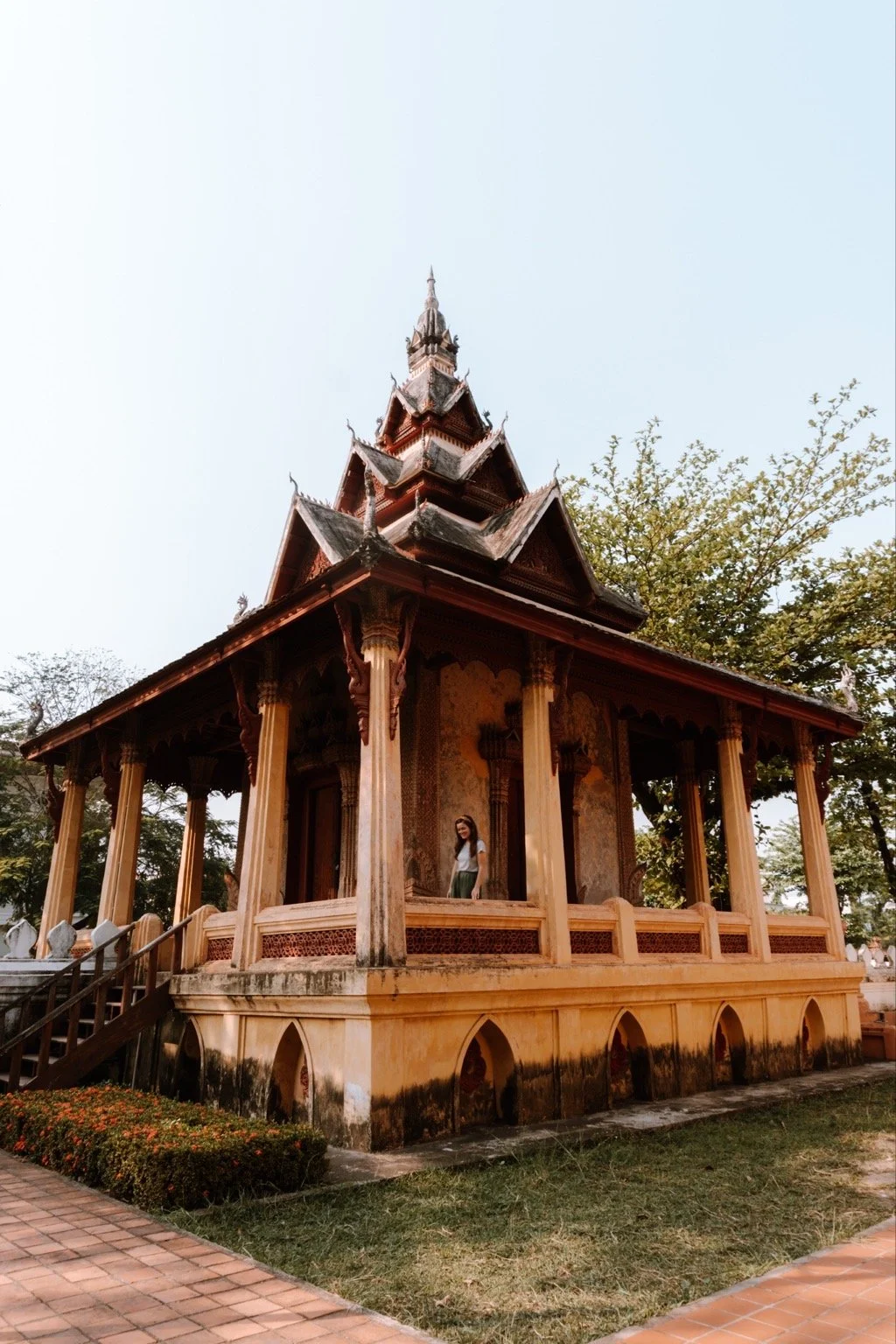20 tips + facts for your first trip to Laos
Planning your first trip to Laos might feel a bit daunting, since information is hard to find online or is missing altogether. Thanks to my extensive time in the country, I’ve put together a list of 20 tips and facts about Laos that will help you know what to expect, what to pack, and how to prepare for the exciting journey ahead!
Visitors tend to pass through on their way to one of its more well-known neighboring countries. I’ve often read blogs about Laos and felt frustrated by the lack of quality and correct information on the web. That’s why I’m hoping my blog is a space with thorough information, maps, and all the details travelers need. And, in regards to Laos, I’m hoping guides like these will help first-time travelers feel prepped and ready.
READ ON FOR TIPS FOR YOUR INAUGURAL VISIT TO LAOS
BASIC KNOWLEDGE OF LAOS
1.The country is pronounced with the s.
You are not visiting “Lao”. You are visiting Lao PDR or Laos. Lao is an ethnicity. It’s also what many locals use to describe products, materials, and traditions that come from Laos. Alternatively, many people refer to things produced in Laos as Laotian. Locals almost never use “Laotian”, however it is technically more correct than Lao when you are describing something specific to ethnic minority culture.
2. there are two main seasons: WET + DRY
Rainy/wet season isn’t as bad as many people think. The pros are fewer tourists, greener views, and cooler temperatures. Of course, the cons are that there are likely to be spells of flooding or heavy rains, which make getting from one place to another difficult {read: landslides that force bus route closures}, and soggy weather ruining photo opportunities. During the dry season, the temperatures soar and there are more tourists. The roads, however, can be really dusty and slash and burn farming techniques make the sky hazy.
3. Public transport across the country is CHEAP, but not as comfortable as other southeast asian destinations
I hate to say this, but traveling around Laos is a pain in the ass. You can fly within the country, but the cost is often high. There is no train {yet}, and so your option is to take the bus. The country is made of windy dirt roads that are less than pleasant to travel on. Journeys via bus are long and arduous, but they are the cheapest way to get from the north to the south of Laos. Most of the time, the bus will stop along its planned route to pick up people waiting on the side of the road. These people will get on the bus even if there are no seats. They’ll simply hunker down in the aisle.
4. The country’s money, Lao Kip, is A CLOSED CURRENCY
Unlike Thai Baht, which you can pick up in most banks prior to your travel plans and exchange in a number of country’s after you’ve returned from vacation, Lao kip is completely unrecognized outside of Laos. You will not be able to exchange the leftover bills you find in your wallet anywhere outside of Laos. Not in Thailand. Not in Vietnam. They’ll just be really confused if you try an exchange in Cambodia. If you don’t exchange your money back before you leave, you could be carrying a very expensive souvenir with you back home.
5. The tourism sector is still in development, set your expectations accordingly
This means it isn’t as developed as the Vietnamese or Thai tourism industries. Expecting the same level of development will set you up for disappointment and, honestly, it’s just plain unrealistic. Remembering that Laos is still developing as a nation broadly speaking might help you to remember that the tourism industry here is on Bambi-legs too.
6. English is spoken fairly well in high-traffic areas
Vientiane, Vang Vieng, and Luang Prabang are towns filled with people who speak spectacular English. Those who don’t speak fluently do a fabulous job of communicating with what little English they do speak and, I promise, their English is better than your Lao. In more rural areas and places with fewer tourists, the language barrier can be very steep. This is a beautiful challenge for those staying in rural homestays with ethnic minorities where English is rarely spoken, and has proven time and time again to me that you don’t always need language to communicate.
7. TALKING ABOUT POLITICS IS A BIG NO-NO
Laos is a communist country. Essentially, locals can vote for their leader…but there is only one party on the ballot. The country is slowly opening up, but speaking about politics {especially with locals} is highly discouraged. By this I mean, the government would not likely punish a tourist, but they do have the power and the reach to punish locals for speaking out against the government. Please, do not speak about politics with a local. Do your research about the politics on highly vetted websites or through reputable news outlets.
PACKING + PREPPING FOR LAOS
8. Pack toilet paper + tampons
Public toilets will almost never have toilet paper, even at certain restaurants. Most public toilets will also be squat toilets, which shouldn’t be scary, since they’re actually much healthy for your digestive and intestinal tract. Nonetheless, squat toilets won’t have toilet roll, so always bring some with you. Tampons are also a rarity in Laos. It is a common culture belief that unmarried women who use tampons are losing their…mmm…virtue. Pads are easier to find, but are often not the same as what you might find in Western destination. Bring your products with you so that you don’t get stuck in an uncomfortable situation.
9. Large rolling suitcases aren’t ideal for most hostels + guesthouses
A vast majority of accommodation, including hotels, do not have elevators {lifts}, so packing light is the best way to insure you make it up to your room with your luggage.
10. Laos is A conservative COUNTRY, dress accordingly
Dressing conservatively is important to help preserve the traditional culture of Laos. When you’re packing for Laos, please bring clothing with you that covers your knees and shoulders. Linens, long skirts, wide-legged trousers, and loose-fitting t-shirts are all great items to have in your suitcase. You might also consider bringing a scarf with you so that you can wear a tank top throughout the day and cover your shoulders when you visit a temple.
Speaking of temples, it is culturally inappropriate to wear clothing that shows your shoulders, knees, or cleavage on temples grounds. Guides will often let you enter the temple grounds wearing what you want, since they don’t want to embarrass you and ask you to cover up. Please do the right thing and dress conservatively. To you it’s one Instagram photo, but over time, if every tourist goes bare-kneed for a quick photo, the rule ceases to exist entirely.
11. Bring bug spray
Dengue fever is common in parts of Laos. This makes it necessary to bring bug spray with you. More important than bringing it, it’s important to wear, even in the day time.
12. Don’t bring too many white clothes
Your clothes aren’t likely to stay white. Laundry services in rural areas will wash your clothing in the river, which is often filled with silt. Over the course of a few washes {occasionally even after a single wash}, your clothing will become a murky beige color.
13. WEAR SHOES THAT ARE EASY TO TAKE OFF + PUT ON
If you are visiting temples, sleeping at a homestay, or spending time with locals, it is expected that you take your shoes off before entering that space. This can be a bit of a pain if you only strappy sandals or lace-up shoes with you on your travels. Birkenstocks and other slip-on shoes are more practical and will have you spending less time putting messing with your footwear in the heat.
CULTURAL + COUNTRYWIDE NORMS
14. When sharing a meal with locals, you eat with your hands
Eating with locals, you will primarily be eating with your hands. Sticky rice is a staple of the Laotian diet. You will roll a ball of sticky rice in your hand and dip it into the other food to eat. Bring hand sanitizer with you and enjoy the experience. You can, alternatively, bring your own silverware with you but expect to get some stares.
15. LAO PEOPLE DRINK THEIR beer in a glass with ice
I know. This is like a craft beer connoisseur’s nightmare. If you are drinking with locals or at a local eatery, your beer will almost definitely come with a glass and a bucket of ice. Beer Lao, the local brew, is easy to drink. In the heat, however, you will be thankful for the ice helping to dilute the alcohol you consume.
16. TIPPING ISN’T typical OR EXPECTED
You aren’t expected to tip a waiter. In fact, you may throw them off entirely if you try to leave a tip. At fancier hotels and restaurants, you may feel more obliged to tip and there might be a gratuity charge some places, but it isn’t a “Lao thing” to tip for service. If you are charged a gratuity, it’s definitely being implemented by a foreign manager. It’s always nice to leave a tip for your tour guide, but you will be the exception rather than the rule.
17. KEEP YOUR VOICE DOWN at TEMPLEs
One thing many of my local friends in Laos comment on is how loud foreigners talk, especially on temple grounds. A friend once said, “You wouldn’t shout in a cathedral, would you?” That broadened my perspective entirely. I’ve found myself more bothered by noise since living in Laos, and more aware of how unaware other people seem to be regarding the reverence of temple grounds. Keep your voice at an appropriate level.
18. Ask for permission before you take photos of people (especially kids + Novices)
This should go without saying, but I’ve actually watched so many visitors taking photos of children like they are zoo animals. Tourists will literally line up along the primary school yard near the main street of Luang Prabang to take photos of the children playing. Anywhere in the Western world, this would be seen as creepy and invasive behaviour. There are heaps of conversations taking place currently about travelers and photography ethics. In Laos, it’s best to ask for consent before taking photos of any locals and to make sure they are being portrayed in a light where they won’t lose face or in a way that won’t feel degrading.
19. BARTERING IS EXPECTEd, BUT KEEP some perspective
I totally get it: most travelers are on a budget of some kind. And, no one wants to get ripped off or scammed. It is expected that you haggle with tuk-tuk drivers and for souvenirs at the night market. However, keep the big picture in mind. The average person in Laos makes somewhere between USD $80-100 per month. If you are arguing with a tuk-tuk driver over 5,000 kip, you are essentially saving yourself USD $0.50, which will probably make more of a difference to them than it will to you. Get a good price, but keep some perspective of the level of poverty that exists.
20. Don’t depend on WiFi, get data
Internet in Laos can be speedy one minute and completely non-existent the next. One of the pains of being a freelance writer based in Laos was the intermittent power outages and the WiFi deciding it needed a day or two off. Of course, this creates a super relaxed vacation and means you’ll be less stuck on your screen. For those of us who need to be online to work it can be a bit frustrating. Buying a SIM card with data will help you stay connected to the interweb. Unitel is the best mobile carrier to get a SIM card from, and you’ll get the most reliable data network from them. Data is relatively cheap and you can pick up a SIM card from almost any corner shop, as well as airports and bus terminals.
































